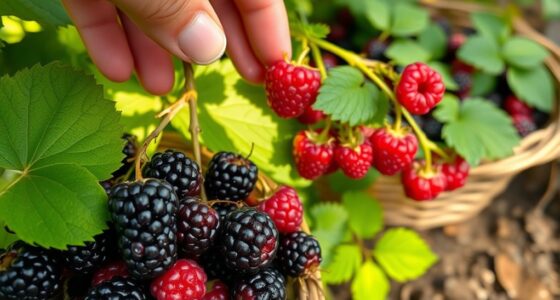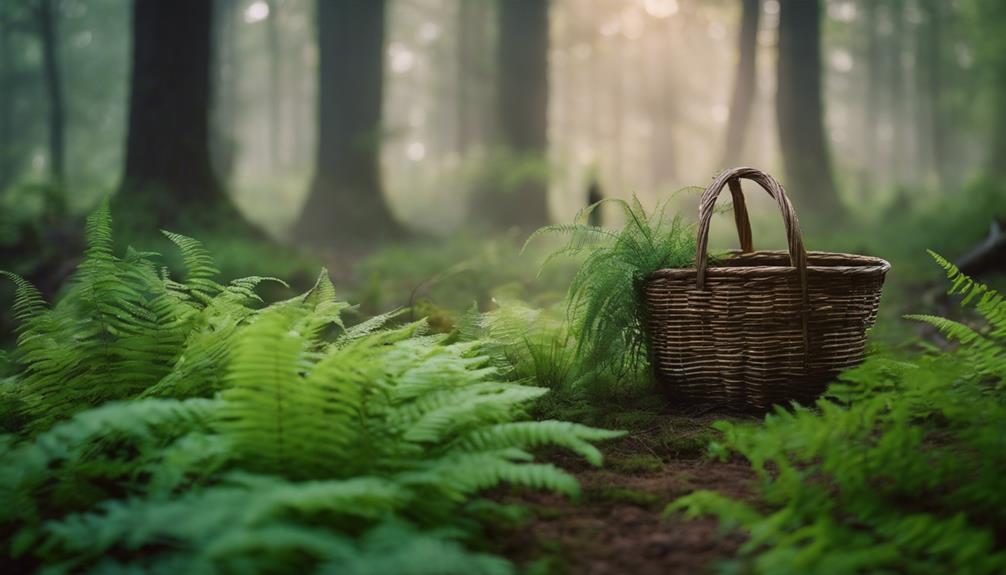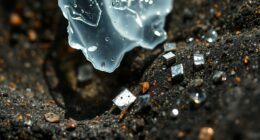When processing wild foods, start by inspecting your harvest for spoiled or damaged items, removing any moldy or questionable pieces. Rinse fruits, berries, or vegetables thoroughly under cold water, gently brushing delicate items like mushrooms to avoid breaking them. Remove dirt, insects, and debris carefully, and separate safe edible species from potential lookalikes or toxins. Proper cleaning and sorting guarantee safety, quality, and flavor—continue exploring to learn effective techniques that keep your wild foods fresh and tasty.
Key Takeaways
- Rinse wild foods thoroughly under cold running water to remove dirt, debris, insects, and residues.
- Use gentle brushing for delicate items like mushrooms to prevent damage and spoilage.
- Inspect harvested items for signs of spoilage, pests, or discoloration; discard questionable or damaged parts.
- Separate edible wild foods from toxic lookalikes, especially when dealing with fungi or uncertain species.
- Remove leaves, stems, and debris to improve safety, taste, and texture before further processing.

Processing wild foods is indispensable to make them safe, edible, and enjoyable. One of the first steps in this process involves cleaning and sorting your harvest properly. When you gather wild plants, fruits, or fungi, you need to apply effective harvesting techniques to guarantee you’re collecting the best quality items. This means choosing the right time and method to gather your wild foods. For example, harvesting berries at their peak ripeness maximizes flavor and nutritional value, while picking mushrooms with a gentle twist minimizes damage and guarantees you don’t harm the organism or introduce contaminants. Proper harvesting techniques also involve avoiding overharvesting, which helps maintain the health and sustainability of wild populations.
Proper harvesting ensures wild foods are safe, high quality, and sustainable.
Once you’ve collected your wild foods, sorting becomes critical to identify what’s edible and discard anything that’s damaged, moldy, or questionable. Sorting involves a careful inspection of your harvest, removing leaves, stems, or debris that shouldn’t be eaten. For fruits and vegetables, look for signs of spoilage or pests, and set aside any items that are soft, discolored, or rotting. When dealing with fungi, it’s imperative to separate edible species from toxic lookalikes. Proper sorting not only enhances the safety of your wild foods but also improves their taste and texture.
Cleaning is the next indispensable step. Rinse your wild foods thoroughly under cold running water to remove dirt, sand, insects, or other residues. For certain items like mushrooms, a gentle brushing with a soft brush can be more effective than soaking, which might cause spoilage. For fruits and berries, soaking briefly can help loosen dirt but should be followed by a quick rinse to prevent spoilage. After cleaning, it’s important to dry your wild foods properly, especially if you plan to store them. Excess moisture can lead to mold and spoilage, so patting them dry with a clean towel or air drying works well.
Seasonal preservation techniques come into play once your wild foods are cleaned and sorted. Preserving your harvest ensures you can enjoy it beyond the immediate season. Freezing, drying, canning, and fermenting are common methods. For example, berries can be frozen or made into jams, while herbs might be dried for later use. Mushrooms can be dried or preserved in oil, and root vegetables can be stored in a cool, dark place. Implementing these seasonal preservation techniques helps you make the most of your wild foods, preventing waste and providing nutritious ingredients long after the harvest season ends. By mastering cleaning, sorting, and preservation, you guarantee your wild foods are safe, delicious, and available all year round.
Frequently Asked Questions
How Do I Identify Edible Wild Foods Safely?
To identify edible wild foods safely, you need to focus on plant identification and toxicity testing. Learn to recognize plants accurately by comparing them to reliable field guides or consulting experts. Always test for toxicity by trying small amounts first and observing any adverse reactions. Never consume wild foods unless you’re 100% sure of their identity and safety, as misidentification can lead to serious health risks.
What Tools Are Best for Cleaning Wild Foods?
For cleaning wild foods safely, you should use effective cleaning tools like brushes, colanders, and knives. A soft-bristled brush helps remove dirt and debris without damaging the food, while a colander is great for rinsing larger quantities. Always use clean, sharp knives for trimming and slicing. These cleaning tools guarantee wild food safety by thoroughly removing contaminants, dirt, and insects, making your wild harvest safe to eat.
How Do I Remove Pesticides From Wild Plants?
You need to be thorough when removing pesticides from wild plants. Start by rinsing them under cold, running water, gently rubbing to loosen residues. For added safety, soak the plants in a mixture of water and a small amount of vinegar for 10-15 minutes, then rinse again. This process of wild plant cleaning guarantees pesticide elimination, making your foraged foods safer and ready to enjoy.
Can Wild Foods Be Stored Long-Term After Processing?
Yes, wild foods can be stored long-term after processing. You should use preservation methods like drying, freezing, or canning to extend their shelf life. Make sure to store them in suitable storage containers, such as airtight jars or vacuum-sealed bags, to prevent spoilage and contamination. Properly processed and stored wild foods can last months or even years, allowing you to enjoy your harvest well into the future.
Are There Specific Techniques for Drying Wild Foods?
Drying wild foods is like turning fresh treasures into lasting gems. You can use dehydration methods like a food dehydrator or air drying techniques, which involve hanging or spreading foods in a well-ventilated, dry area. Guarantee low humidity and good airflow to prevent mold. Turn or rotate items regularly, and store once fully dried. These techniques preserve nutrients and flavor, making your wild harvest last longer.
Conclusion
Now that you know the essentials of cleaning and sorting wild foods, you’re practically a culinary wizard in the making. Properly prepared, these foods can transform your meals into extraordinary feasts that could outshine even the most celebrated restaurants. Remember, thorough cleaning isn’t just a step—it’s the secret to *unleashing* nature’s bounty safely and deliciously. With these basics under your belt, you’re ready to impress everyone with your wild food skills, turning simple foraging into an art form.










